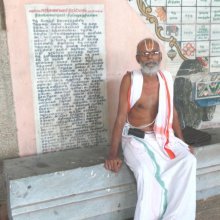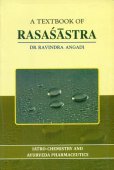Sudha, Sudhā: 33 definitions
Introduction:
Sudha means something in Hinduism, Sanskrit, Jainism, Prakrit, Buddhism, Pali, the history of ancient India, Marathi, Hindi, biology. If you want to know the exact meaning, history, etymology or English translation of this term then check out the descriptions on this page. Add your comment or reference to a book if you want to contribute to this summary article.
Images (photo gallery)
In Hinduism
Ayurveda (science of life)
Nighantu (Synonyms and Characteristics of Drugs and technical terms)
Source: WorldCat: Rāj nighaṇṭuSudhā (सुधा) is another name for Śāliparṇī, a medicinal plant identified with Desmodium gangeticum (sal leaved desmodium), from the Fabaceae or “legume” family of flowering plants, according to verse 4.17-20 of the 13th-century Raj Nighantu or Rājanighaṇṭu. The fourth chapter (śatāhvādi-varga) of this book enumerates eighty varieties of small plants (pṛthu-kṣupa). Together with the names Sudhā and Śāliparṇī, there are a total of twenty-nine Sanskrit synonyms identified for this plant.
Agriculture (Krishi) and Vrikshayurveda (study of Plant life)
Source: Shodhganga: Drumavichitrikarnam—Plant mutagenesis in ancient IndiaSudhā (सुधा) refers to “nectar-like (fruits)” which were created using a recipe for manipulating the taste of fruits (on the tree), according to the Vṛkṣāyurveda by Sūrapāla (1000 CE): an encyclopedic work dealing with the study of trees and the principles of ancient Indian agriculture.—Accordingly, “A tree which normally produces pungent fruits starts producing fruits sweet like the nectar (sudhā) if thickly smeared at the root with the paste of the mixture made out Embelia ribes, Glycyrrhiza glabra, barley, milk and jaggery”.
Unclassified Ayurveda definitions
Source: Wisdom Library: Āyurveda and botanySudhā (सुधा) is a Sanskrit word referring to “milk-hedge”, a flowering plant from the Euphorbiaceae (spurge) family, and is used throughout Ayurvedic literature such as the Caraka-saṃhitā. The official botanical name of the plant is Euphorbia neriifolia and is commonly known in English as “holy milk hedge” or “dog’s tongue”. The literal translation of Sudhā is “welfare, ease, comfort”. As a traditional medicine, it is used in various recipes such as an Alkaline ash for cautery.

Āyurveda (आयुर्वेद, ayurveda) is a branch of Indian science dealing with medicine, herbalism, taxology, anatomy, surgery, alchemy and related topics. Traditional practice of Āyurveda in ancient India dates back to at least the first millenium BC. Literature is commonly written in Sanskrit using various poetic metres.
Shilpashastra (iconography)
Source: Shodhganga: The significance of the mūla-beras (śilpa)Sudhā (सुधा) refers to a “special kind of mortar/plaster”, representing materials used for the making of images (Hindu icons), as defined in the texts dealing with śilpa (arts and crafs), known as śilpaśāstras.—The materials listed in the Āgamas for the making of images are wood, stone, precious gems, metals, terracotta, laterite, earth, and a combination of two or three or more of the materials specified above. The materials recommended in the śilpaśāstra for the fashioning of images are unburnt clay, burnt clay as in brick or terracotta, sudhā (a special kind of mortar/plaster), composite earth, wood, stone, metal, ivory, dhātu (mineral), pigment, and precious stones.
Source: Shodhganga: Elements of Art and Architecture in the Trtiyakhanda of the Visnudharmottarapurana (shilpa)1) Sudhā (सुधा) or Sudhācūrṇa refers to “powder of lime (plaster)” and represents one of the various substances used in the process of creating a Canvas, in the ancient Indian art of Painting (citra), according to the Viṣṇudharmottarapurāṇa, an ancient Sanskrit text which (being encyclopedic in nature) deals with a variety of cultural topics such as arts, architecture, music, grammar and astronomy.—Canvas is a kind of surface on which a painter can draw a picture. In ancient time walls are seen to be plastered with different substances (i.e., sudhā-cūrṇa) and these were prepared for Painting. [...] For the process of kuḍya i.e., plastering on a wall, the painter needs iṣṭakācūrṇa i.e., powder of bricks and mṛd i.e., clay as basic ingredients. [...] Along with this mixture, some more ingredients [viz., sudhā-cūrṇa i.e., powder of lime, ... etc.] should be mingled. After that, the mixture should be transferred to a touch stone mortar for the process of pounding.
2) Sudhā (सुधा) or “lime” refers to one of the materials used to make Colours in the ancient Indian tradition of Painting (citra).

Shilpashastra (शिल्पशास्त्र, śilpaśāstra) represents the ancient Indian science (shastra) of creative arts (shilpa) such as sculpture, iconography and painting. Closely related to Vastushastra (architecture), they often share the same literature.
Vastushastra (architecture)
Source: OpenEdition books: Architectural terms contained in Ajitāgama and RauravāgamaSudhā (सुधा) refers to ““stucco” §§ 2.8, 13, 16, 17, 28; 4.7; 5.3.”.—(For paragraphs cf. Les enseignements architecturaux de l'Ajitāgama et du Rauravāgama by Bruno Dagens)

Vastushastra (वास्तुशास्त्र, vāstuśāstra) refers to the ancient Indian science (shastra) of architecture (vastu), dealing with topics such architecture, sculpture, town-building, fort building and various other constructions. Vastu also deals with the philosophy of the architectural relation with the cosmic universe.
Purana and Itihasa (epic history)
Source: archive.org: Shiva Purana - English TranslationSudhā (सुधा) refers to the “nectar”, according to the Śivapurāṇa 2.3.17 (“The dialogue between Indra and Kāmadeva”).—Accordingly, as Kāma said to Brahmā: “[...] O dear friend, I shall cause the downfall of that enemy of yours who is performing a severe penance to usurp your position. [...] I can undoubtedly make Brahmā and Viṣṇu go astray. Others are of no consideration. I shall make even Śiva fall. I have only five arrows that are soft and flowery. My bow is of three types. That too is flowery. The bowstring consists of bees. My support and strength is my beloved wife Ratī. Spring is my minister. O god, I am having five forces. The moon, the storehouse of nectar [i.e., sudhā-nidhi], is my friend. [...]”.

The Purana (पुराण, purāṇas) refers to Sanskrit literature preserving ancient India’s vast cultural history, including historical legends, religious ceremonies, various arts and sciences. The eighteen mahapuranas total over 400,000 shlokas (metrical couplets) and date to at least several centuries BCE.
Yoga (school of philosophy)
Source: Brill: Śaivism and the Tantric Traditions (yoga)Sudhā (सुधा) refers to “nectar”, according to the Amṛtasiddhi, a 12th-century text belonging to the Haṭhayoga textual tradition.—Accordingly, “The moon is on the peak of Meru and has sixteen digits. Facing downwards, it rains dewy nectar (sudhā—tuṣārābhāṃ sudhāṃ) day and night”.

Yoga is originally considered a branch of Hindu philosophy (astika), but both ancient and modern Yoga combine the physical, mental and spiritual. Yoga teaches various physical techniques also known as āsanas (postures), used for various purposes (eg., meditation, contemplation, relaxation).
Shaktism (Shakta philosophy)
Source: Google Books: ManthanabhairavatantramSudhā (सुधा) refers to the “wine” (which inebriates the Goddesses’ consort), according to the Kularatnoddyota, one of the earliest Kubjikā Tantras.—Accordingly, “[...] Energized by the (mantras called the) Five Jewels, enveloped by the seven bodily constituents, her nature the wine (sudhā-svarūpiṇī) (that inebriates her consort) and divine, she is coloured with the colour of the principles of existence. That goddess is (the god’s) own will, Bhairavī, (who is in the company) of the God of the gods. [...]”.

Shakta (शाक्त, śākta) or Shaktism (śāktism) represents a tradition of Hinduism where the Goddess (Devi) is revered and worshipped. Shakta literature includes a range of scriptures, including various Agamas and Tantras, although its roots may be traced back to the Vedas.
Pancaratra (worship of Nārāyaṇa)
Source: Shodhganga: Kasyapa Samhita—Text on Visha Chikitsa (p)Sudhā (सुधा) refers to “nectar”, according to the second chapter of the Kāśyapa Saṃhitā: an ancient Sanskrit text from the Pāñcarātra tradition dealing with both Tantra and Viṣacikitsā (Toxicology).—Accordingly, text text dictates that a Garuḍa-upāsaka, the aspirant, must meditate on Garuḍa of the following form—[...] Garuḍa, seated on a lotus, adorned with these ornaments [i.e., the eight divine serpents], has huge wings and immense energy. Garuḍa of smiling countenance, blazes with eight shoulders adorned by the weapons—conch, discus, nectar-pot (sudhā-kumbha), serpent, mace, and sword and two hands reaching out to the feet of the Lord.

Pancaratra (पाञ्चरात्र, pāñcarātra) represents a tradition of Hinduism where Narayana is revered and worshipped. Closeley related to Vaishnavism, the Pancaratra literature includes various Agamas and tantras incorporating many Vaishnava philosophies.
Sports, Arts and Entertainment (wordly enjoyments)
Source: archive.org: Syainika Sastra of Rudradeva with English Translation (art)Sudhā (सुधा) refers to “plaster” (used for whitewhashing a building), according to the Śyainika-śāstra: a Sanskrit treatise dealing with the divisions and benefits of Hunting and Hawking, written by Rājā Rudradeva (or Candradeva) in possibly the 13th century.—Accordingly, [while discussing the treatment of hawks]: “Hawks should be kept tied in a quiet place on the top of a lofty building, beautifully whitewashed (sudhā-dhavalita) and cooled with sprays of water by means of machines; fans should be moved gently and at intervals, by men placed at a distance ; and the place should be kept free from flies by means of netted windows”.

This section covers the skills and profiencies of the Kalas (“performing arts”) and Shastras (“sciences”) involving ancient Indian traditions of sports, games, arts, entertainment, love-making and other means of wordly enjoyments. Traditionally these topics were dealt with in Sanskrit treatises explaing the philosophy and the justification of enjoying the pleasures of the senses.
In Jainism
General definition (in Jainism)
Source: The University of Sydney: A study of the Twelve ReflectionsSudha (सुध) refers to the “nectar (waters)” (of true restraint), according to the 11th century Jñānārṇava, a treatise on Jain Yoga in roughly 2200 Sanskrit verses composed by Śubhacandra.—Accordingly, “One who is restrained who is intent on stopping the influx of karma fearlessly drives away the discharge of the poison of non-restraint with the nectar waters of true restraint (satsaṃyama-sudhā-ambu). A bad birth is hard to be accomplished even in a dream for him whose judgment, which is extremely skilful at examination like a door-keeper, shines in the mind”.
Synonyms: Sudhā, Nirmala.
Source: SOAS Research Online: Prekṣā meditation: History and MethodsSudha (सुध) or “pure” refers to one of the 46 qualities of the soul to be meditated on in the “Practice of Meditation on Liberated Souls (Siddhas)”, according to Jain texts like Ācārāṅga (5.6.123-140), Ṣaṭkhaṇḍāgama (13.5.4.31) and Samayasāra (1.49).—The pure soul can be recognised by meditation on its true nature, represented by the liberated souls of the Siddhas. The practice which leads to this realisation is meditation on the fact that attachment, aversion, passions and the influx of karmas, are ‘not mine’, that I am separate from them and consist of infinite knowledge, perception, conduct, spiritual energy, that I am the pure, enlightened, and everlasting soul. The qualities of the soul to be meditated on as truly mine are: [e.g., My soul is pure (sudha)] [...] The meditation on such extended fourty-five qualities of the pure soul presents the niśacaya-naya, which is aligned with Kundakunda’s approach.

Jainism is an Indian religion of Dharma whose doctrine revolves around harmlessness (ahimsa) towards every living being. The two major branches (Digambara and Svetambara) of Jainism stimulate self-control (or, shramana, ‘self-reliance’) and spiritual development through a path of peace for the soul to progess to the ultimate goal.
India history and geography
Source: Shodhganga: a concise history of Sanskrit Chanda literature (history)Sudhā (सुधा) is the name of a commentary (on Vṛttaratnākara of Kedārabhaṭṭa) ascribed to Cintāmaṇi Daivajña (17th century). This work was composed in 1634 C.E.; 4 years later of Prastāracintāmaṇi of the author. Like Prastāracintāmaṇi, Cintāmaṇi also praises Lord Gaṇeśa with various adjectives, in the invocatory verse of the work. He says: “For smooth completion of my work, I pray Lord Gaṇeśa, whose cheeks are red as the vermilion (sindūra), who stays in the heart of Pārvatī along with other Śaiva deities”.

The history of India traces the identification of countries, villages, towns and other regions of India, as well as mythology, zoology, royal dynasties, rulers, tribes, local festivities and traditions and regional languages. Ancient India enjoyed religious freedom and encourages the path of Dharma, a concept common to Buddhism, Hinduism, and Jainism.
Biology (plants and animals)
Source: Wisdom Library: Local Names of Plants and DrugsSudha [ସୁଧା] in the Odia language is the name of a plant identified with Tinospora cordifolia from the Menispermaceae (Moonseed) family. For the possible medicinal usage of sudha, you can check this page for potential sources and references, although be aware that any some or none of the side-effects may not be mentioned here, wether they be harmful or beneficial to health.
Source: Google Books: CRC World Dictionary (Regional names)1) Sudha in India is the name of a plant defined with Desmodium gangeticum in various botanical sources. This page contains potential references in Ayurveda, modern medicine, and other folk traditions or local practices It has the synonym Hedysarum lanceolatum Schumach. (among others).
2) Sudha is also identified with Euphorbia neriifolia It has the synonym Tithymalus edulis (Lour.) H. Karst. (etc.).
3) Sudha is also identified with Euphorbia nivulia It has the synonym Euphorbia nivulia var. helicothele (Lem.) Boiss. (etc.).
4) Sudha is also identified with Euphorbia royleana It has the synonym Euphorbia pentagona Haw. (etc.).
5) Sudha is also identified with Opuntia stricta It has the synonym Cactus strictus Haw. (etc.).
6) Sudha is also identified with Terminalia chebula It has the synonym Myrobalanus chebula Gaertn. (etc.).
Example references for further research on medicinal uses or toxicity (see latin names for full list):
· Cell and Chromosome Research (1984)
· Taxon (1981)
· Resultati Scientifici della missione Stefanini-Paoli nella Somalia Italiana (1916)
· Illustrations of the Botany of the Himalayan Mountains (1836)
· Repert. Bot. Syst. (Walpers) (1842)
· Journal of Cytology and Genetics (1990)
If you are looking for specific details regarding Sudha, for example extract dosage, chemical composition, pregnancy safety, side effects, health benefits, diet and recipes, have a look at these references.

This sections includes definitions from the five kingdoms of living things: Animals, Plants, Fungi, Protists and Monera. It will include both the official binomial nomenclature (scientific names usually in Latin) as well as regional spellings and variants.
Languages of India and abroad
Pali-English dictionary
Source: BuddhaSasana: Concise Pali-English Dictionarysudhā : (f.) the embrosia; lime; chunnam.
Source: Sutta: The Pali Text Society's Pali-English DictionarySudhā, (f.) (cp. Sk. sudhā) 1. the food of the gods, ambrosia J. V, 396; Vism. 258=KhA 56 (sakkhara°).—2. lime, plaster, whitewash, cement Vin. II, 154; °-kamma whitewashing, coating of cement J. VI, 432; Mhvs 38, 74. (Page 719)

Pali is the language of the Tipiṭaka, which is the sacred canon of Theravāda Buddhism and contains much of the Buddha’s speech. Closeley related to Sanskrit, both languages are used interchangeably between religions.
Marathi-English dictionary
Source: DDSA: The Molesworth Marathi and English Dictionarysudhā (सुधा).—f (S) The beverage of immortality and sustenance of the gods, nectar. 2 The nectar or honey of flowers. 3 Mortar, plaster, chunam. 4 (In Sanskrit.) Juice; water; lightning; the milkbush; yellow myrobalan &c.
--- OR ---
sudhā (सुधा).—a (śuddha S) Right, correct, proper, becoming, fit. Ex. sudhā bōlarē nāṛyā bōḍakyā jhālyā sāṛyā.
Source: DDSA: The Aryabhusan school dictionary, Marathi-Englishsudhā (सुधा).—f Nectar. Mortar. Juice. a Right, proper.
Marathi is an Indo-European language having over 70 million native speakers people in (predominantly) Maharashtra India. Marathi, like many other Indo-Aryan languages, evolved from early forms of Prakrit, which itself is a subset of Sanskrit, one of the most ancient languages of the world.
Sanskrit dictionary
Source: DDSA: The practical Sanskrit-English dictionarySudhā (सुधा).—[suṣṭhu dhīyate, pīyate dhe-dhā vā ka Tv.]
1) The beverage of the gods, nectar, ambrosia; निपीय यस्य क्षितिरक्षणः कथां तथाद्रियन्ते न बुधाः सुधामपि (nipīya yasya kṣitirakṣaṇaḥ kathāṃ tathādriyante na budhāḥ sudhāmapi) N.1.1.
2) The nectar or honey of flowers.
3) Juice.
4) Water.
5) Name of the Ganges.
6) White-wash, plaster, mortar; कैलासगिरिणेव सुधासितेन प्राकारेण परिगता (kailāsagiriṇeva sudhāsitena prākāreṇa parigatā) K.; कालान्तरश्यामसुधेषु नक्तम् (kālāntaraśyāmasudheṣu naktam) R.16. 18.
7) A brick.
8) Lightning.
9) The milk-hedge plant.
1) Emblic myrobalan.
11) Yellow myrobalan.
Source: Cologne Digital Sanskrit Dictionaries: Shabda-Sagara Sanskrit-English DictionarySudhā (सुधा).—f.
(-dhā) 1. Nectar, the beverage of immortality and sustenance of the gods. 2. The nectar or honey of flowers. 3. Juice. 4. Plaster, mortar. 5. A brick. 6. The Ganges. 7. Water. 8. Lightning. 9. The milk-hedge plant, (Euphorbia antiquorum, &c.) 10. A plant, (Aletris Hyacinthoides.) 11. Emblic myrobalan. 12. Yellow myrobalan. E. su pleasure, dhe to drink, or dhā the have, to support, (life,) aṅ and ṭāp affs.
Source: Cologne Digital Sanskrit Dictionaries: Benfey Sanskrit-English DictionarySudhā (सुधा).—[su-dhā], and -dhe + a, f. 1. Plaster, mortar, [Rāmāyaṇa] 2, 80, 13; [Daśakumāracarita] in
Sudhā (सुधा).—1. [feminine] welfare, comfort.
--- OR ---
Sudhā (सुधा).—2. [feminine] nectar or milk (lit. good drink); chalk, rough-cast.
Source: Cologne Digital Sanskrit Dictionaries: Aufrecht Catalogus Catalogorum1) Sudhā (सुधा) as mentioned in Aufrecht’s Catalogus Catalogorum:—See Nyāyasudhā, Vākyasudhā, Sāhityasudhā.
2) Sudhā (सुधा):—Vṛttaratnākaraṭīkā by Cintāmaṇi.
Source: Cologne Digital Sanskrit Dictionaries: Monier-Williams Sanskrit-English Dictionary1) Sudhā (सुधा):—[=su-dhā] [from su > su-tanaya] 1. su-dhā f. (√1. dhā; for 2. su-dhā etc. See sub voce) welfare, ease, comfort, [Atharva-veda; Aitareya-brāhmaṇa]
2) [=su-dhā] 2. su-dhā f. ([from] 5. su-√dhe; for 1. su-dhā, ‘welfare’ See [column]2) ‘good drink’, the beverage of the gods, nectar (cf. 2. dhātu, p.514), [Mahābhārata; Kāvya literature] etc.
3) [v.s. ...] the nectar or honey of flowers, [cf. Lexicographers, esp. such as amarasiṃha, halāyudha, hemacandra, etc.]
4) [v.s. ...] juice, water, [cf. Lexicographers, esp. such as amarasiṃha, halāyudha, hemacandra, etc.]
5) [v.s. ...] milk (also [plural]), [Varāha-mihira’s Bṛhat-saṃhitā; Pañcarātra]
6) [v.s. ...] white wash, plaster, mortar, cement, [Mahābhārata; Rāmāyaṇa] etc.
7) [v.s. ...] a brick, [cf. Lexicographers, esp. such as amarasiṃha, halāyudha, hemacandra, etc.]
8) [v.s. ...] lightning, [cf. Lexicographers, esp. such as amarasiṃha, halāyudha, hemacandra, etc.]
9) [v.s. ...] the earth, [Demetrius Galanos’s Lexiko: sanskritikes, anglikes, hellenikes]
10) [v.s. ...] Euphorbia Antiquorum or another species, [Caraka]
11) [v.s. ...] Sanseviera Roxburghiana, [cf. Lexicographers, esp. such as amarasiṃha, halāyudha, hemacandra, etc.]
12) [v.s. ...] Glycine Debilis, [cf. Lexicographers, esp. such as amarasiṃha, halāyudha, hemacandra, etc.]
13) [v.s. ...] Emblica or yellow Myrobalan, [cf. Lexicographers, esp. such as amarasiṃha, halāyudha, hemacandra, etc.]
14) [v.s. ...] a kind of metre, [Kedāra’s Vṛtti-ratnākara]
15) [v.s. ...] Name of the, wife of a Rudra, [Bhāgavata-purāṇa]
16) [v.s. ...] of the Ganges, [cf. Lexicographers, esp. such as amarasiṃha, halāyudha, hemacandra, etc.]
17) [v.s. ...] Name of various works.
Source: Cologne Digital Sanskrit Dictionaries: Yates Sanskrit-English DictionarySudhā (सुधा):—(dhā) 1. f. Juice, water; nectar, ambrosia; nectar of flowers; plaster, brick; the Ganges; myrobalan; name of several plants.
Source: DDSA: Paia-sadda-mahannavo; a comprehensive Prakrit Hindi dictionary (S)Sudhā (सुधा) in the Sanskrit language is related to the Prakrit word: Chuhā.
[Sanskrit to German]
Sanskrit, also spelled संस्कृतम् (saṃskṛtam), is an ancient language of India commonly seen as the grandmother of the Indo-European language family (even English!). Closely allied with Prakrit and Pali, Sanskrit is more exhaustive in both grammar and terms and has the most extensive collection of literature in the world, greatly surpassing its sister-languages Greek and Latin.
Hindi dictionary
Source: DDSA: A practical Hindi-English dictionary1) Sudha (सुध) [Also spelled sudh]:—(nf) memory; consciousness, senses; -[budha] memory; consciousness, senses; •[khonā/0na rahanā] see —[na rahanā; -dilānā] to remind; —[na rahanā] to forget; to lose or be out of senses; —[bisaranā] to forget; to lose or be out of senses; —[lenā] to remember; to enquire after.
2) Sudhā (सुधा):—(nf) nectar; ~[kara/dhara/nidhi] the moon; ~[rasa] nectar; ~[vṛpṭi] rain of nectar—plenty and prosperity.
...
Prakrit-English dictionary
Source: DDSA: Paia-sadda-mahannavo; a comprehensive Prakrit Hindi dictionarySuḍha (सुढ) in the Prakrit language is related to the Sanskrit word: Smṛ.
Prakrit is an ancient language closely associated with both Pali and Sanskrit. Jain literature is often composed in this language or sub-dialects, such as the Agamas and their commentaries which are written in Ardhamagadhi and Maharashtri Prakrit. The earliest extant texts can be dated to as early as the 4th century BCE although core portions might be older.
Kannada-English dictionary
Source: Alar: Kannada-English corpusSudha (ಸುಧ):—[adverb] = ಸುದಾ [suda].
--- OR ---
Sudhā (ಸುಧಾ):—[adverb] = ಸುದಾ [suda].
--- OR ---
Sudhā (ಸುಧಾ):—[noun] = ಸುಧೆ [sudhe].
Kannada is a Dravidian language (as opposed to the Indo-European language family) mainly spoken in the southwestern region of India.
Nepali dictionary
Source: unoes: Nepali-English Dictionary1) Suḍha (सुढ):—n. trunk (of an elephant) snout;
2) Sudha (सुध):—n. memory; recollection; remembrance;
3) Sudhā (सुधा):—adj. pl. of सुधो [sudho]
Nepali is the primary language of the Nepalese people counting almost 20 million native speakers. The country of Nepal is situated in the Himalaya mountain range to the north of India.
See also (Relevant definitions)
Partial matches: Dha, Cu, Shu, Ta.
Starts with (+247): Cutacankitai, Cutacci, Cutacinturam, Cutai, Cutai-velaikaran, Cutaikkunru, Cutakacatturu, Cutakaculai, Cutakanka, Cutakapantam, Cutakapattiyam, Cutakappantu, Cutakapperukku, Cutakavali, Cutakavayu, Cutakevali, Cutalam, Cutalan, Cutali, Cutam.
Ends with (+23): Acaravakyasudha, Advaitabrahmasudha, Akhyatavadavyakhyasudha, Alamkarasudha, Atikshudha, Chandahsudha, Chhandahsudha, Citsudha, Gangaramasudha, Govindarcanasudha, Govindarcanavasudha, Janmavasudha, Karnasudha, Kavyasudha, Kshetravasudha, Kshudha, Laghumimamsavarttikatika laghunyayasudha, Laghunyayasudha, Mahasudha, Mahusudha.
Full-text (+199): Sudhadhara, Sudhavarsha, Sudhasrava, Sudhanga, Sudhahara, Sudhanidhi, Sudhahrit, Sudhadrava, Sudhasuti, Sudhavasa, Sudhamshu, Sudhamaya, Sudharashmi, Sudharasatva, Sudhasitata, Chuha, Sudhavrishti, Sudhajivin, Sudhadharakvathastotra, Sudhayoni.
Relevant text
Search found 63 books and stories containing Sudha, Su-dhā, Su-dha, Sudhā, Suḍha, Sudhaa; (plurals include: Sudhas, dhās, dhas, Sudhās, Suḍhas, Sudhaas). You can also click to the full overview containing English textual excerpts. Below are direct links for the most relevant articles:
Sahitya-kaumudi by Baladeva Vidyabhushana (by Gaurapada Dāsa)
Text 4.93 < [Chapter 4 - First-rate Poetry]
Text 10.74 < [Chapter 10 - Ornaments of Meaning]
Text 10.7 < [Chapter 10 - Ornaments of Meaning]
Bhakti-rasamrta-sindhu (by Śrīla Rūpa Gosvāmī)
Verse 3.2.171 < [Part 2 - Affection and Service (dāsya-rasa)]
Verse 1.2.281 < [Part 2 - Devotional Service in Practice (sādhana-bhakti)]
Verse 1.2.282 < [Part 2 - Devotional Service in Practice (sādhana-bhakti)]
Garga Samhita (English) (by Danavir Goswami)
Verse 2.15.2 < [Chapter 15 - Description of Śrī Rādhā-Kṛṣṇa’s Falling in Love]
Verse 5.18.2 < [Chapter 18 - Uddhava Hears the Gopīs’ Words and Returns to Mathurā]
Verse 5.20.4 < [Chapter 20 - The Liberation of Ṛbhu Muni During the Rāsa-dance Festival]
Charaka Samhita (English translation) (by Shree Gulabkunverba Ayurvedic Society)
Chapter 10 - The Pharmaceutics of the Thorny Milk-hedge Plant (sudha-kalpa) < [Kalpasthana (Kalpa Sthana) — Section on Pharmaceutics]
Brihad Bhagavatamrita (commentary) (by Śrī Śrīmad Bhaktivedānta Nārāyana Gosvāmī Mahārāja)
Verse 1.5.94 < [Chapter 5 - Priya (the beloved devotees)]
Verse 2.1.3 < [Chapter 1 - Vairāgya (renunciation)]
Verse 2.4.30 < [Chapter 4 - Vaikuṇṭha (the spiritual world)]
Chaitanya Bhagavata (by Bhumipati Dāsa)
Verse 3.1.165 < [Chapter 1 - Meeting Again at the House of Śrī Advaita Ācārya]
Verse 1.16.133 < [Chapter 16 - The Glories of Śrī Haridāsa Ṭhākura]
Verse 2.23.211 < [Chapter 23 - Wandering about Navadvīpa On the Day the Lord Delivered the Kazi]
Related products







